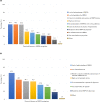Current realities of home blood pressure monitoring from physicians' perspectives: results from Asia HBPM survey 2020
- PMID: 37041412
- PMCID: PMC10319632
- DOI: 10.1038/s41440-023-01259-1
Current realities of home blood pressure monitoring from physicians' perspectives: results from Asia HBPM survey 2020
Abstract
Uncontrolled hypertension is a significant problem in many parts of Asia. Effective management is essential to reduce the burden of hypertension. Home blood pressure monitoring (HBPM) is a promising tool that can aid in the diagnosis and management of hypertension. Experts from 11 countries/regions in Asia conceptualized a large-scale survey to examine the current realities of HBPM. A cross-sectional survey was conducted among health care professionals from China, India, Indonesia, Japan, Malaysia, the Philippines, Singapore, South Korea, Taiwan, Thailand, and Vietnam between November 2019 and June 2021. Physicians' responses were summarized using descriptive statistics. A total of 7945 physicians participated in the survey. Among all respondents, 50.3% and 33.5% viewed HBPM as highly recognized by physicians and patients in their country/region, respectively. Lack of understanding of HBPM and concern with the accuracy and reliability of HBPM devices were identified as key barriers to HBPM recognition. Nearly all physicians (95.9%) reported recommending HBPM to their patients; however, they reported less than 50% of their patients measured home blood pressure (HBP). Among physicians who recommended HBPM, only 22.4% and 54.1% cited HBP diagnostic threshold values and timing of taking antihypertensive drugs that were consistent with available guidelines, respectively. The survey reveals that the recognition of HBPM as a valuable tool to diagnose and manage hypertension is suboptimal in most parts of Asia. Despite high recommendation of HBPM to hypertensive patients by physicians, there are considerable discrepancies between guidelines recommendations and practice realities. The recognition of HBPM as a valuable tool for the diagnosis and management of hypertension is suboptimal among both physicians and patients in Asia. A clear and consistent guidance for proper HBPM practice and use of validated and calibrated HBP monitors are among the top priorities to support the integration of HBPM into daily patient care. HBPM: home blood pressure monitoring, HBP: home blood pressure.
Keywords: Asia; Home blood pressure monitoring; Hypertension.
© 2023. The Author(s).
Conflict of interest statement
T-D.W. has received research grants and honoraria from Omron Healthcare Co. Ltd. T.O. has received grants from Omron Healthcare Co. Ltd. M.L.B. has received honoraria from Omron Philippines. Y.C.C. has received speaker honorarium and sponsorship from Boeringher-Ingelheim, Pfizer, Omron, and Servier and Xepa-Sol to attend conferences and seminars, and investigator-initiated research and educational grants from Pfizer, Omron, and Viatris. K.K. has received grants from Omron Healthcare, Fukuda Denshi, and A&D Co. C.H.K. received honoraria from Omron Korea. N.M. is an employee of Omron Healthcare Singapore Pte. Ltd. S.P. has received honoraria from Pfizer, Boryoung, Hanmi, Daewoong, Donga, Celltrion, Servier and Daiichi Sankyo, and Daewon, and research grants from Daiichi Sankyo. E.S. is an employee of Omron Healthcare Co. Ltd. I.T. is an employee of Omron Healthcare India Private Ltd. J-G.W. has received grants from Novartis and Omron, and lecture and consulting fees from Merck, Novartis, Servier and Viatris. All other authors have no relevant relationships to disclose.
Figures






Comment in
-
Sympathetic nervous activation and hypertension.Hypertens Res. 2023 Jul;46(7):1636-1637. doi: 10.1038/s41440-023-01319-6. Epub 2023 Jul 5. Hypertens Res. 2023. PMID: 37402815 No abstract available.
Similar articles
-
Physicians' knowledge, awareness and instructions of home blood pressure monitoring: Asia HBPM survey in Taiwan.Hypertens Res. 2025 Jan;48(1):60-67. doi: 10.1038/s41440-024-01925-y. Epub 2024 Oct 8. Hypertens Res. 2025. PMID: 39379465
-
Awareness and recommendation of home blood pressure measurement among physicians in India: Results from Asia HBPM survey 2020.Indian Heart J. 2023 May-Jun;75(3):169-176. doi: 10.1016/j.ihj.2023.04.004. Epub 2023 Apr 23. Indian Heart J. 2023. PMID: 37088141 Free PMC article.
-
Insights on home blood pressure monitoring in Asia: Expert perspectives from 10 countries/regions.J Clin Hypertens (Greenwich). 2021 Jan;23(1):3-11. doi: 10.1111/jch.14074. Epub 2020 Oct 11. J Clin Hypertens (Greenwich). 2021. PMID: 33043574 Free PMC article. Review.
-
The reason why home blood pressure measurements are preferred over clinic or ambulatory blood pressure in Japan.Hypertens Res. 2013 Aug;36(8):661-72. doi: 10.1038/hr.2013.38. Epub 2013 Apr 18. Hypertens Res. 2013. PMID: 23595050 Review.
-
Primary-care physicians' views about the use of home/self blood pressure monitoring: nationwide survey in Hungary.J Hypertens. 2006 Sep;24(9):1729-35. doi: 10.1097/01.hjh.0000242396.15097.f3. J Hypertens. 2006. PMID: 16915021
Cited by
-
Hypertension research 2024 update and perspectives: blood pressure management.Hypertens Res. 2025 May;48(5):1733-1738. doi: 10.1038/s41440-025-02130-1. Epub 2025 Mar 7. Hypertens Res. 2025. PMID: 40055495 Review.
-
Office and home blood pressure and their difference according to frailty status among community-dwelling older adults: the NOSE study.Hypertens Res. 2025 Apr;48(4):1389-1398. doi: 10.1038/s41440-025-02145-8. Epub 2025 Feb 14. Hypertens Res. 2025. PMID: 39953238 Free PMC article.
-
Current practices and knowledge of home blood pressure monitoring among people with hypertension: Insights from a Multicentric study from North India.Indian Heart J. 2024 Nov-Dec;76(6):398-404. doi: 10.1016/j.ihj.2024.11.249. Epub 2024 Nov 22. Indian Heart J. 2024. PMID: 39579976 Free PMC article.
-
Commentary on 'Physician knowledge, awareness and instructions of home blood pressure monitoring: Asia HBPM survey in Taiwan' a large gap between the guidelines and reality.Hypertens Res. 2025 Mar;48(3):1221-1222. doi: 10.1038/s41440-024-02058-y. Epub 2024 Dec 13. Hypertens Res. 2025. PMID: 39672923 No abstract available.
-
Home blood pressure-based treatment with hypertension specialists: a better strategy for overcoming uncontrolled blood pressure.Hypertens Res. 2025 Apr;48(4):1656-1659. doi: 10.1038/s41440-025-02140-z. Epub 2025 Feb 13. Hypertens Res. 2025. PMID: 39948182
References
MeSH terms
LinkOut - more resources
Full Text Sources
Medical
Miscellaneous

